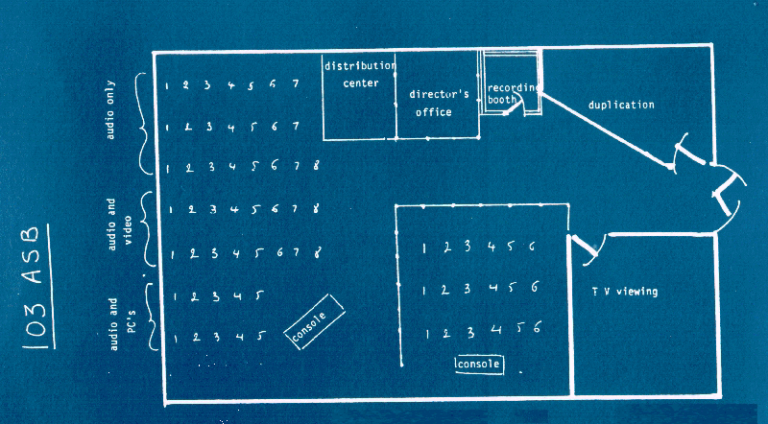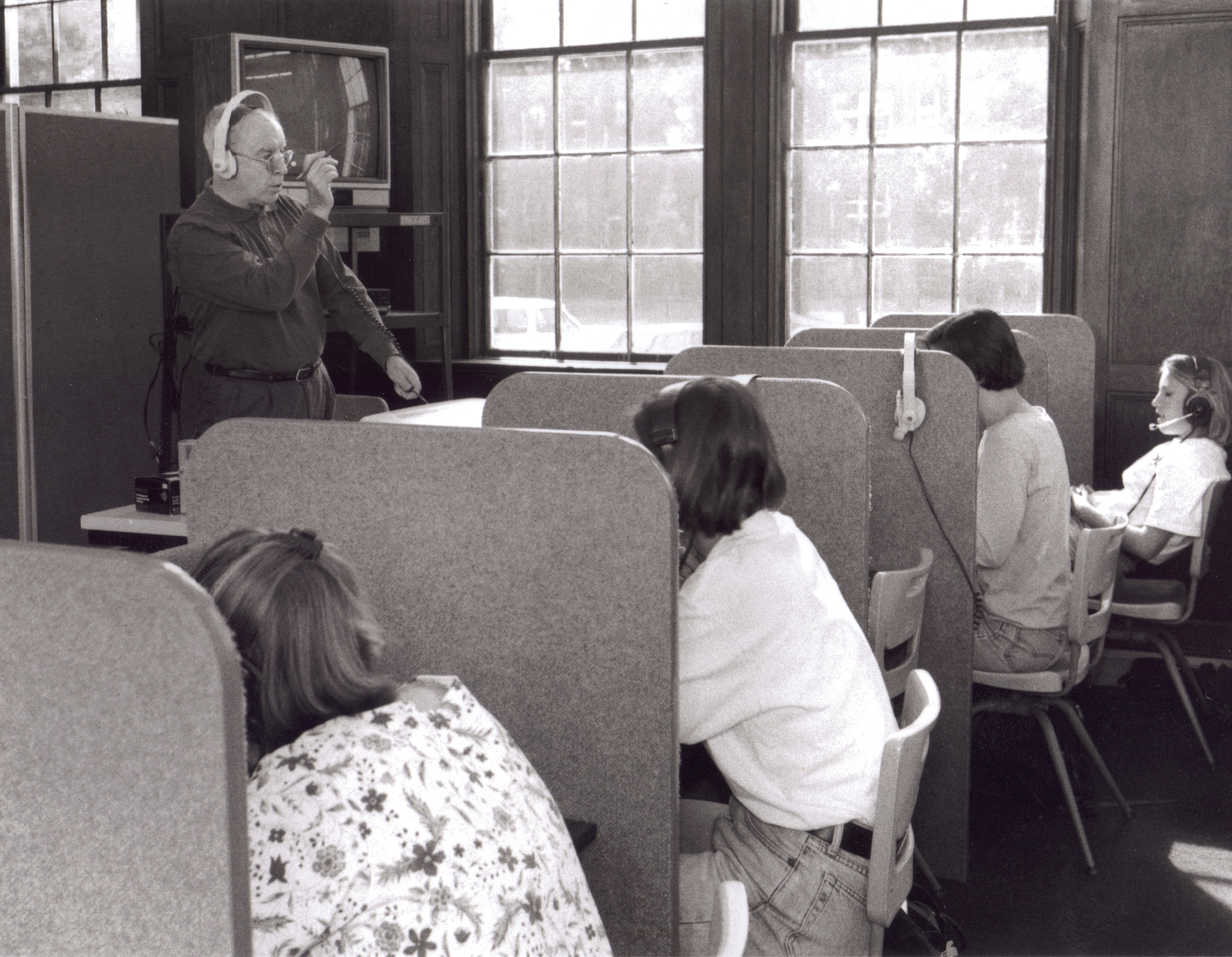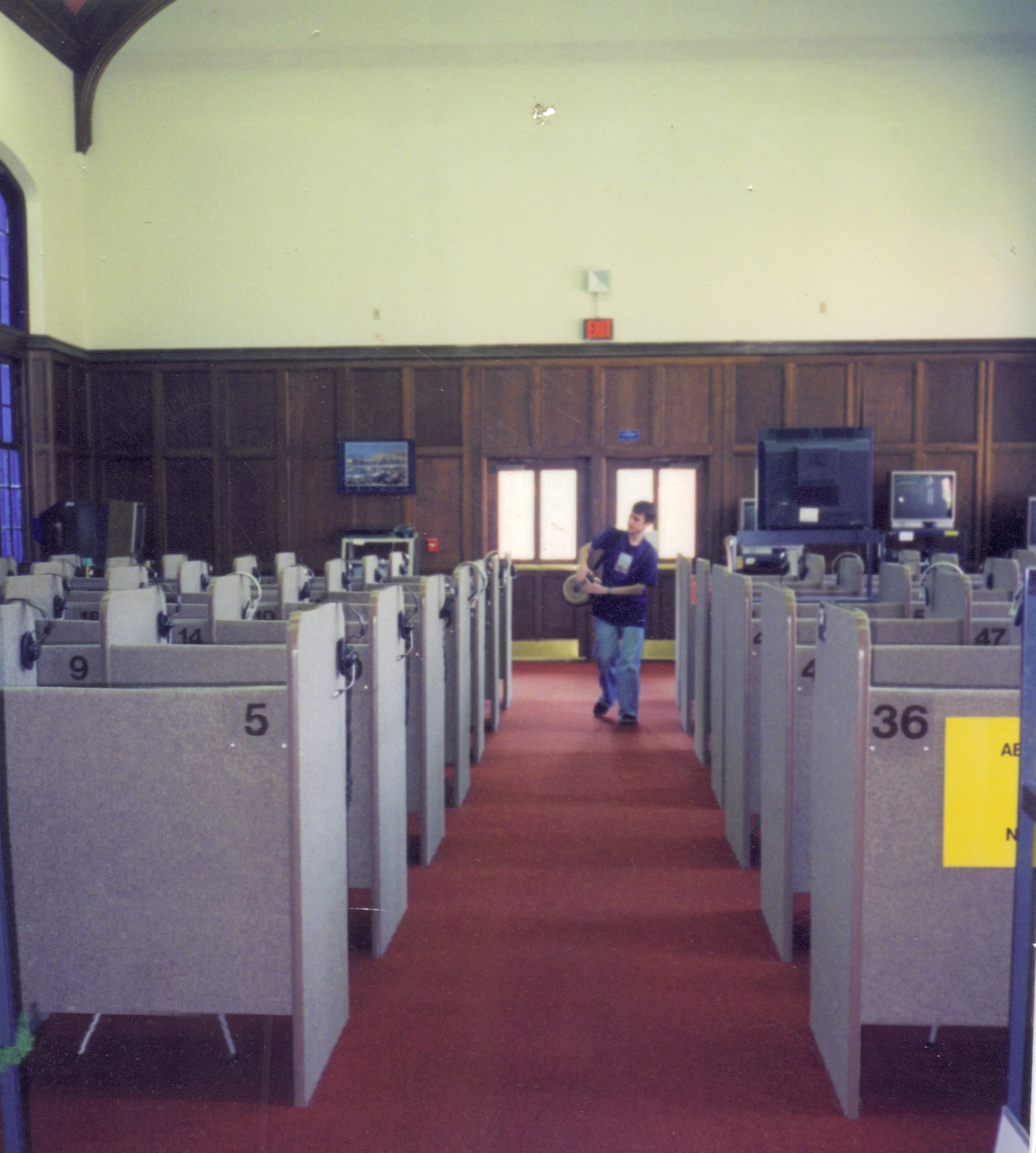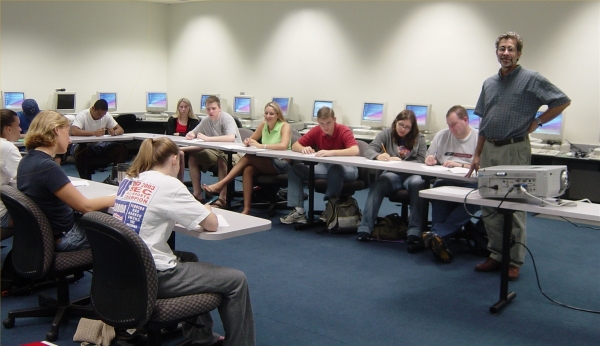A View of Academic Resources, from 1949 to today
 In 1913 UF opened its Language Hall (now Anderson Hall, but still bearing the original name on the façade facing University Avenue). The building was never only or even mainly used by the language departments, however, and in the 1930s the teaching of languages was subsumed into another department. However, after World War II, there was again a separate Languages Department; French was the most important foreign language taught, though German and Spanish were also offered, as well as Classical Greek and Latin. At that time, there was a tradition of learning foreign languages primarily in order to read great literature. In 1949, department chair Ernest Atkin recruited a young Frenchman, Pierre Capretz, to teach French; Capretz, whose broad interests included science as well as letters, initiated a program which emphasized speaking and listening in a contemporary cultural context. His innovations included a French cinema festival, improvised visual materials such as magazine clippings and humorous drawings for overhead projectors, and audio recordings on wax disks and magnetic wire (he wanted to use movie cameras but was unable to obtain them). Under a new chair, Joseph Brunet, Capretz was able to experiment with magnetic tape recorders and install a substantial audio lab in the basement of Anderson Hall. At the time, the taped materials had to be created by instructors, and Pierre Capretz, who went on to create the revolutionary telecourse French in Action, came up with many delightful and memorable exercises. The lab’s technician was a Hungarian-Transylvanian immigrant and novelist, Albert Wass de Czege, who kept the lab going for a while after Capretz’s departure for Yale in 1956. UF continued to innovate and experiment with audio-visual language instruction (in what would now be called a communicative approach) during the 1950s.
In 1913 UF opened its Language Hall (now Anderson Hall, but still bearing the original name on the façade facing University Avenue). The building was never only or even mainly used by the language departments, however, and in the 1930s the teaching of languages was subsumed into another department. However, after World War II, there was again a separate Languages Department; French was the most important foreign language taught, though German and Spanish were also offered, as well as Classical Greek and Latin. At that time, there was a tradition of learning foreign languages primarily in order to read great literature. In 1949, department chair Ernest Atkin recruited a young Frenchman, Pierre Capretz, to teach French; Capretz, whose broad interests included science as well as letters, initiated a program which emphasized speaking and listening in a contemporary cultural context. His innovations included a French cinema festival, improvised visual materials such as magazine clippings and humorous drawings for overhead projectors, and audio recordings on wax disks and magnetic wire (he wanted to use movie cameras but was unable to obtain them). Under a new chair, Joseph Brunet, Capretz was able to experiment with magnetic tape recorders and install a substantial audio lab in the basement of Anderson Hall. At the time, the taped materials had to be created by instructors, and Pierre Capretz, who went on to create the revolutionary telecourse French in Action, came up with many delightful and memorable exercises. The lab’s technician was a Hungarian-Transylvanian immigrant and novelist, Albert Wass de Czege, who kept the lab going for a while after Capretz’s departure for Yale in 1956. UF continued to innovate and experiment with audio-visual language instruction (in what would now be called a communicative approach) during the 1950s.
Dauer Hall Language Labs
 Dauer Hall was built in 1936 as the Florida Union, the students’ social center. In 1965, the new J. Wayne Reitz Student Union was finished, and by 1968 the old Florida Union was converted to offices and re-named the Arts and Sciences Building (ASB). It now housed the Language departments, Classics, Linguistics, Speech, Anthropology, and Communication Sciences. At this time, the ballroom was partitioned to create a language lab. In the late 1980s, the building was re-named Dauer Hall, after the distinguished political science professor Manning J. Dauer. From 1970-97, the University of Florida Language lab was housed in Dauer Hall, in the former ballroom, a two-story room with tall windows and dark-raftered vault that was probably meant to inspire “the boys of Old Florida” with a spirit of guild-hall brotherhood. Whatever its acoustic defects, it was undoubtedly the least claustrophobic lab in the country.
Dauer Hall was built in 1936 as the Florida Union, the students’ social center. In 1965, the new J. Wayne Reitz Student Union was finished, and by 1968 the old Florida Union was converted to offices and re-named the Arts and Sciences Building (ASB). It now housed the Language departments, Classics, Linguistics, Speech, Anthropology, and Communication Sciences. At this time, the ballroom was partitioned to create a language lab. In the late 1980s, the building was re-named Dauer Hall, after the distinguished political science professor Manning J. Dauer. From 1970-97, the University of Florida Language lab was housed in Dauer Hall, in the former ballroom, a two-story room with tall windows and dark-raftered vault that was probably meant to inspire “the boys of Old Florida” with a spirit of guild-hall brotherhood. Whatever its acoustic defects, it was undoubtedly the least claustrophobic lab in the country.

This Chester “control panel” was succeeded in the mid-70s by a Wollensack lab which used audiocassettes, finally turning over some control of the tapes to the students. The Wollensack lab was installed and administered by the Office of Instructional Resources (OIR), under Dr. Jeanine Webb; OIR continued to run the lab until 2001.

With the advent of VCRs and personal computers, however, the possibility of visual and textual aids to learning foreign languages was enticing. By the late 1980s, the language faculty had expanded in numbers, in languages taught, and also in prestige. The professors were well aware that the quality of the students in their classes depended on sound teaching at the elementary and intermediate levels. Some of them produced their own elementary audio materials, while others designed computer drills. The lab needed to change.

In 1987, three Sony LLC-5510 computerized, interactive teaching consoles and sophisticated student player/recorder units were installed, complemented by television sets with audio fed into the student units, and a small computer lab.

The design finally chosen for the new Sony lab was simple, with 70 audio stations in two sections, each section linked by a console and facing 4 television sets, allowing it to be used with great flexibility as an audio classroom or a video/audio library facility. This is the period, under the direction of Inés Márquez Chisholm, when the facility was named the Language Learning Center; it eventually counted 15 TVS and 12 VCRs, plus a multi-standard setup (for playing European videotapes) and a laserdisk player, as part of the equipment for individual and group video. A third Sony classroom, with 15 student stations, but equipped with computers in addition, was installed in 215 Dauer, upstairs from the main lab.
At this time, also, a massive program for duplicating the lab manual tapes for home use was instituted, since even the enlarged lab could not accommodate all UF’s language students.

Move to Turlington Hall
In the meantime, however, 103 Dauer Hall appealed to the College as a project for restoration to its original glory as a social meeting-place, the Keene Faculty Center, which opened in November 1998 and is much used for meetings of all kinds. The upstairs computer lab, in Dauer 215, was also restored as a small conference room. Two Sony consoles, the student players, and 50 of the booths were moved to two rooms in Turlington Hall.

The facilities in 1341 and 1317 Turlington included, in the late 1990s, a “library” area for individual work on audio and video reserve materials, and a separate classroom, particularly suitable as an audio testing facility. In November, 1998, three computers were placed in the lab so that students could access the Little Hall classroom software and other important language tools during open hours.

In 1999-2000 the student staff produced over 16,000 authorized copies of audiocassettes for lab and home use, and assisted students in using audio, video, and computer equipment 8,500 times. They were available to set up the console for instructors bringing their classes to Turlington for about 450 periods.
In the summer of 2000, the Language Learning Center staff began digitizing lab audio so that students could access it over the internet. The online “Virtual Language Lab” served most students in the elementary language courses, though some still preferred to do their work in the lab, or even to listen to tapes until they fell out of use. As the decade wore on, publishers began taking back the responsibility for distributing lab audio to students, via the internet, and the local distribution became much less important.
Little Hall Computer Classrooms

Late in 1995, the deans of the College of Liberal Arts and Sciences announced their interest in promoting language learning through new facilities. The first step in this direction was a dedicated computer classroom in Little Hall, which allowed access to multimedia materials. As in 1986, the faculty’s proposed design (in 1996, a Mac lab with students facing the instructor at their computer desks) was not implemented. At just this time the World Wide Web was being developed, and the new facility was equipped to take advantage of this. Also, a floor plan which maximized mobility and flexibility was chosen. After a year or so the lab was recognized by most instructors who used it as a superb language teaching space. Not only did the computers allow direct contact with contemporary cultural materials, but the room lent itself to a more collaborative, social model of learning.
In the year 2000, language use of the Little Hall facilities was expanded. The former statistics lab next to Little 225 became available for language instruction, and eventually (in 2006-7) was given a similar flexible layout. The rooms were popular for language classes because of their open space and the options for forming small conversation groups. For various reasons, however, the use of the rooms by language classes was restricted and finally, in 2016-17, the rooms were taken away from languages so that Math could experiment with teaching in an open layout.
The New Millennium

By Spring of 2000, it became clear that the 13-year-old Sony labs were aging beyond our ability to repair them. In the meantime, digital interfaces emulating language lab players and instructor consoles had been developed, allowing video as well as audio to be manipulated by students and instructors in the lab. This interplay of text, images, and sound had not been possible before, and offered quite a different experience from the old “drill and kill” of listening to audiotapes.

In 2001, under Sue Legg of OIR and CLAS Associate Deans Jack Sabin and Carol Murphy, a wall was knocked down, expanding the small former classroom Turlington 1317 to twice its size. The installation of a Tandberg digital language lab in Turlington 1341, the expansion of the “library area” to include more workroom for lab assistants dealing with more kinds of media, and better facilities for students using the media,–all this happened in 2001 as a joint project of OIR and the College of Liberal Arts and Sciences. CLAS now took over administrative responsibility for the Turlington labs, so that the Little and Turlington rooms were officially united in a single facility under Director Judy Shoaf.
Thus the history of the UF language lab came full circle, as the labs, originally maintained by the academic Department of Foreign Languages and Literatures, came back to faculty control in CLAS.
Renovations
In 2006-08, the Language Learning Center benefited from a federal grant to CLAS. Associate Dean Yumiko Hulvey was instrumental in obtaining this major renovation. New equipment for all the labs and new furniture where needed gave all the labs a new and superior design.




CLAS Academic Resources and the place of the Language Learning Center: 2016 and beyond
Beginning in 2014, the College of Liberal Arts and Sciences began to move to consolidate various spatial and administrative resources, among them the Language Learning Center and also the Teaching Center, whose role in helping students succeed in STEM courses is vital to Florida’s future. Beginning in the Fall of 2015, Little 215 was turned into a tutoring center. The following year, Little 225 was handed over to Math for experiments in new teaching styles.
At the same time, Turlington 1317 was provided with a new glass door and updated to include less electronic equipment but more mobile chairs,tables, and partitions to allow collaborative work. Associate Dean Margaret Fields oversaw the streamlining and evolution of the Language Learning Center into a Language Studio. The redesigned room immediately became attractive to groups meeting for scheduled or improvised conversation and tutoring.
Whither the Language Lab?
The radical changes in ownership and use of electronic devices has changed the nature and role of the Language Learning Center. In 1987, the IBM 286es installed in Dauer 215 were useful as wordprocessors and “patient tutors” waiting for the student to fill in a blank with the correct term, properly conjugated or declined. The novelty of controlling playback of a jumpy videotape had not replaced the experience of watching a projected film. Ten years later, a few students were taking notes on laptops, and such media as laserdisks and DVDs began to offer a high-quality classroom or private experience of films. Wordprocessing on an MS-DOS or early Windows machine, however, was still limited to Western alphabets.
More importantly, though, by the late 90s, the World Wide Web made available immediate contact with other nations as they existed at this moment–not when a book was written or a movie shot. Languages could be heard spoken by all kinds of people and in many different places, and their changes and novelty became more evident. Another ten years pass, and though students still need textbooks and–very much so!–teachers, they are capable of working collaboratively, sharing their experiences of a language. In the almost 30 years since the Language Learning Center got its name, it is no longer a place to sit in front of a machine and do what the instructor tells you, repeating set phrases. Rather, students meet to practice conversation or work on projects together, or to learn how to use a piece of equipment they own to complete an assignment. Still, imitating a functionality that was available through the primitive Sony instructor computer of 1987, the Turlington Sanako lab can be useful in permitting students to converse with supervision for an entire class period.
Compiled by Judy Shoaf, with much thanks to the late Jean Casagrande, Jerry McCune, Mike Summers, Lee Neil, Wayne Daniels, and the late Wayne Wolfe. For information about the 1950s lab, I thank Celinda Scott, Etienne Brunet, and Pierre Capretz.